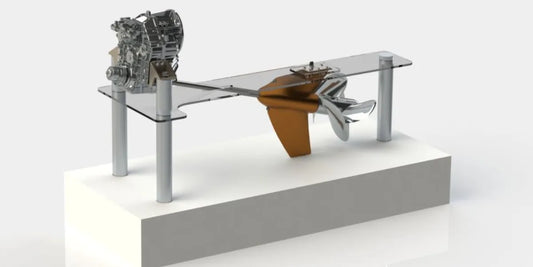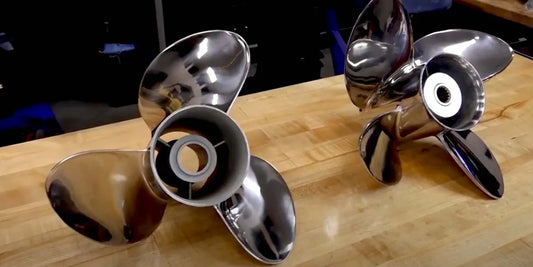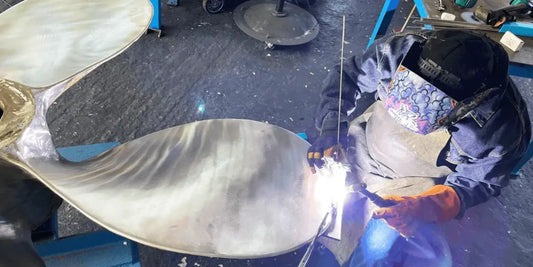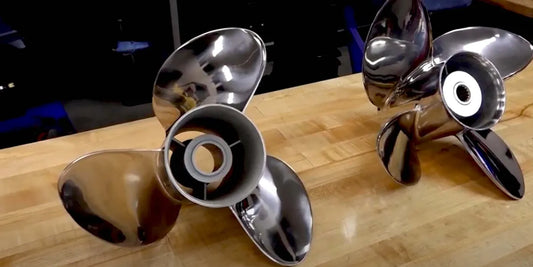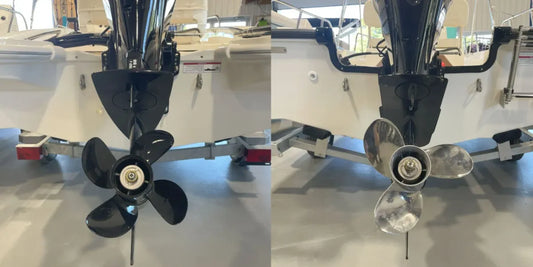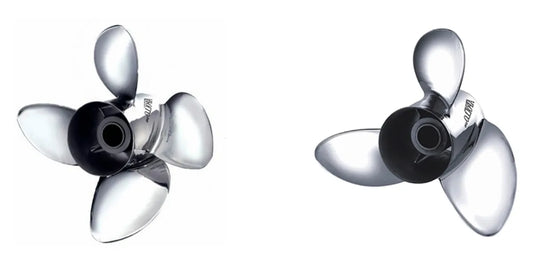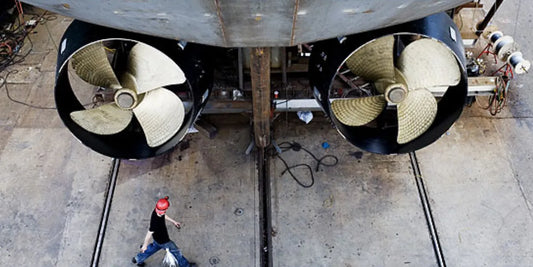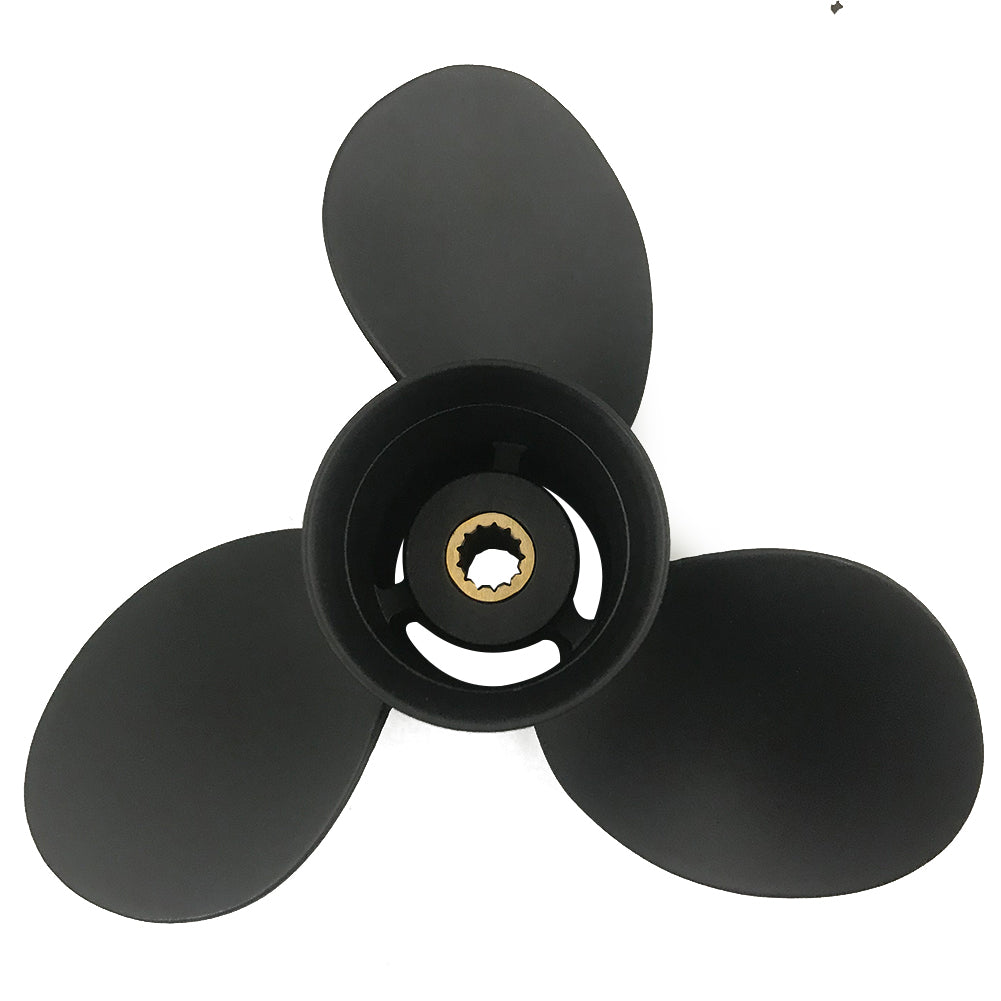Choosing between aluminum and stainless steel propellers for your boat can influence the aluminum stainless steel performance. Being made of different materials, these two have their pros and cons, and many boat owners find it hard to decide which suits them best. Speed? Durability? Efficiency? Maybe cost? Many factors should be taken into consideration. Therefore, any boat owner must understand the pros and cons of each kind of prop along with their appropriate applications. This article highlights some key differences that distinguish aluminum from stainless steel boat props, allowing you to select the one that best matches your goals and conditions. From performance parameters to maintenance concerns, you will learn it all and reposition yourself to make the right choice, so you never regret that decision.
Introduction to Boat Propellers

Understanding Boat Prop Types
Boat propellers are classified differently, based on the material, blade design, and their intended use, each factor affecting their efficiency and performance. Aluminum and stainless steel are the two most commonly used materials for boat propellers. Aluminum is lightweight and affordable, making it ideal for casual boaters who seek moderate speed and medium performance from their propeller. Stainless steel is more durable and suited for harsher conditions; hence, it favors high-performance boats, maintaining its close tolerances even at higher speeds.
Blade design further refines the level of suitability a propeller can achieve. The propellers can be either 3-or 4-bladed; 3-bladed propellers provide better top-end speed, while 4-bladed ones offer smoother handling at slower speeds and faster acceleration. Additionally, the correct pitch and diameter values for any given propeller are vital for achieving thrust and RPM balance, improving fuel efficiency, and maximizing power output. Keeping these factors in mind, it is essential to select a material and design that best suits your boating needs and water conditions.
Importance of Choosing the Right Propeller
More than just compatibility, the choice of a propeller affects the boat's overall performance, fuel economy, and engine life. Studies indicate that improper propeller selection can reduce fuel efficiency by up to 20%, thereby increasing operating costs and contributing to a rough ride. Stainless steel propellers, for instance, are more expensive, but they last longer and perform better at high speeds and under heavy loads compared to aluminum ones. Likewise, changes to the prop pitch alter boat performance between speed and torque, refocusing its use on the given activity it will be utilized for: water sports, fishing, or cruising.
Technological innovations, including cupped blades and variable pitch technology, serve to assist in staying adaptable to whatever water conditions may prevail, thereby lowering cavitation and providing proper grip in choppy waters. Factoring in engine make, boat size, and primary use helps determine the performance and longevity value of propellers.
Brief Introduction: Aluminum versus Stainless Steel Props
Aluminum or stainless steel-by material consideration—is an important choice to make vis-a-vis one's choice of propeller as both alternatives have their advantages to suit particular needs. Aluminum props are generally popular because they are relatively inexpensive and easy to repair, which is particularly beneficial for casual boaters or those operating in shallow waters, where the risk of damage is significantly higher. Sometimes considered not heavy enough, aluminum props could be said to have a sufficient performance level for most recreational uses; however, they could warp when running at high RPMs and lose some efficiency.
Stainless steel propellers are renowned for their durability and strength, and they typically deliver top performance under special conditions. They will maintain their form even at high speeds, thus allowing for excellent acceleration and speed consistency. The stainless steel material would also make them corrosion-resistant, making them perfect for saltwater operating environments. Statistics show that stainless steel propellers make for about five times more life afforded than aluminum ones, and that certainly justifies their higher up-front costs that a keen boater would consider paying. These stainless steel props also tend to feature more technically advanced designs, such as laser-cut blades, which enhance fuel economy and reduce cavitation.
Ultimately, the answer comes down to a combination of factors, including budget, boat size, typical water conditions, and performance considerations. Those who prioritize maximum reliability and top-notch performance tend to opt for stainless steel, whereas those more concerned with economics and general utility will generally choose aluminum.
Aluminum Propellers: Features and Benefits

Advantages of Aluminum Boat Props
Aluminum boat propellers are a standard purchase for the average boater due to their affordability, versatility, and user-friendliness. Cost-related is one of its main advantages. Aluminum props are significantly cheaper than stainless steel ones, making this affordable alternative ideal for those with limited budgets. Since it is both light and strong, the propeller must be sturdy enough to sail through moderate conditions. Under ordinary working conditions, it efficiently serves small to mid-sized boats.
The second significant advantage is the chances of repair. Minor damages incurred by aluminum props can be repaired more cost-effectively than with more expensive alternatives, such as a stainless steel replacement. Therefore, boats with various configurations, available in aluminum, can choose the one that best suits their needs.
The performance runs well at medium speeds with aluminum props and in situations where high speed and heavy-duty performance are not required. Due to their lower weight, less strain is transmitted to the engine, which theoretically improves fuel economy when cruising at normal speeds.
Ultimately, aluminum boat propellers are an economical choice for recreational boaters seeking easy maintenance and reliable performance under normal conditions.
Common Applications for Aluminum Propeller
Having shouldered the label of one of the most versatile and cost-effective steel propellers in the marine industry, aluminum propellers find diversified applications. Their application is common to the recreational boat industry, where moderate speed and standard performance suffice for club members of aluminum, low- to mid-size motorboats, pontoons, and personal watercrafts, for leisure activities such as fishing, cruising, and water sports.
The second primary application is among the boats operating in fresh or shallow waters, where underwater hazards pose a greater threat of hitting. Being a more affordable option for repair, aluminum is ideal under such circumstances. Aluminum propellers, too, are preferred by amateur or frugal boat owners who value pragmatism and performance.
With manufacturing advancements, today's aluminum propellers offer superior aerodynamic profiles that prioritize fuel efficiency, yet they remain well-performing in diverse situations. Through these applications, several thousand aluminum propellers remain, still harboring the potential for practical accommodation under various boating needs in diverse conditions.
Maintaining and Caring for Aluminum Props
Maintenance and care of aluminum propellers are essential to keep them in proper working condition and ensure they perform well. The inspection must be regular and include every sign of wear, such as dents, cracks, or corrosion, as these damages can alter the efficiency and balance of the propeller. Cleaning after every use with fresh water, especially after exposure to saltwater, is recommended to avoid corrosion and residue buildup. Any type of abrasive cleaning material may damage the finish. For any stubborn residues and marine growth, use a soft brush with a mild cleanser.
To ensure consistent performance, periodically check the propeller's alignment and mounting hardware. Loose or damaged hardware could induce vibrations, leading to a decrease in fuel efficiency. The shaft is usually sprayed with a marine-grade anti-corrosion spray or grease to prevent rust, making it easier to remove. The pitch of the propeller and the integrity of the blades also require monitoring to promote stable operation, particularly after an impact against underwater debris.
When it comes to more involved repairs, inspection or repair services can be sought for significant damage or to regain performance through repitching or rebalancing. With regular maintenance and prompt intervention when problems arise, aluminum propellers can provide reliable performance, thereby reducing costs over time through fewer repairs and replacements.
Stainless Steel Propellers: Features and Benefits

Advantages of Stainless Steel Boat Props
Stainless steel propellers are considered highly durable and efficient, offering a significant measure of long-term reliability and performance, and are therefore preferred by boat owners. The strength-to-weight ratio is the main advantage of these props, as they do not bend to a certain degree when subjected to stresses under adverse circumstances, such as fast currents or shallow waters. Thus, stainless steel propellers depreciate slowly in terms of repairs and replacements, while offering better performance value.
Another benefit of stainless steel props is their increased performance ability. Due to their inherent rigidity, other types of engineering may be more precise, enabling even complex designs that feature thin blades, which offer maximum efficiency and minimal drag. This can translate to improved speed, acceleration, and fuel economy compared to aluminum counterparts. The real benefit, too, is that stainless steel is resistant to corrosion and will maintain performance standards from both saltwater and freshwater applications, warranting the utmost confidence from potential operators under all environmental conditions.
When enthusiasts and professionals consider maximum handling, stainless steel is the ideal material for achieving smooth maneuverability and control. A variety of modern designs tend to reduce vibrations and increase thrust, making these props the go-to choice for finer boating experiences. In the program of stainless steel propellers, one gets the added value of utmost resilience, performance, and efficient operational life for the vessel user.
Typical Applications for Stainless Steel Propellers
In various fields of maritime activity, stainless steel propellers are utilized due to their unparalleled endurance and performance. The most notable instance of usage is in recreational boating, where acceleration, top speed, and fuel efficiency are improved for motorboats and yachts. Commercial vessels, such as fishing boats and ferries, depend on stainless steel props to sustain heavy loads and operate efficiently over long distances. On the other hand, these propellers are sought after in competitive water sports for their precise engineering capabilities and high resistance to deformation, which guarantees speed and agility.
One of the best perks they have is that they can work well in demanding environments, such as saltwater operations. In terms of corrosion resistance, stainless steel is preferable for vessels navigating coastal and offshore waters. Stainless steel propellers for large ships and industrial applications are designed to withstand extreme mechanical stresses, thereby ensuring reliability and minimal maintenance requirements over prolonged periods of service. Thanks to modern materials and design techniques, these props have been able to meet the needs of virtually all types of vessels, regardless of performance level, and guarantee durability.
Maintenances and Care for Stainless Steel Props
When it comes to propellers, the primary maintenance involves ensuring their longevity and functionality. Maintenance shall always begin with regular inspections for damage caused by dents, cracks, or corrosion from underwater debris or chemical exposure. Once the marine growth, salt deposits, and grime are removed through cleaning, the propeller's surface is smooth, enabling efficient operation. Cleaning shall be performed with non-abrasive materials to preclude damage to the propeller.
The application of an anti-corrosion coating or polish specifically designed for stainless steel would render the stainless steel propellers more resistant to seawater and other environmental factors, thereby minimizing the possibility of wear over extended periods. Likewise, shafts and seals shall be checked to ensure that the waterproof and lubrication efficacies are maintained, or else further damage would be inflicted upon operations or other adjacent components.
There is always a need for performance monitoring, as vibrations during operation may indicate misalignment or physical damage that must be addressed immediately. In cases of heavy use or harsh environmental conditions, inspections and dynamic balancing are advantageous when performed by professionals. Storage during the off-season must be carried out correctly to maintain the condition and efficiency of the propeller; for instance, storing the propeller in a dry and covered place.
A thorough maintenance program underscores the increase in performance, durability, and cost efficiency of stainless steel propellers, while steering clear of sudden repair costs or operational downtime.
Comparing Aluminum and Stainless Steel Propellers

Differences in Propulsion Performance of Aluminum and Stainless Steel
One very important factor to consider is performance, affected by the materials chosen and design, when comparing aluminum and stainless steel propellers. Stainless steel propellers are denser and more rigid than aluminum, which allows the shape of the blades to remain precise under greater stress conditions. With such rigidity, the performance is improved at high speeds and during demanding operations, such as towing or navigating through turbulent waters.
In contrast, aluminum propellers are considered somewhat basic and affordable options for smaller boats or hobby use. Due to aluminum's softness, it can result in deformation under loads or very high RPMs, which in the latter stages might somewhat reduce the propeller's efficiency. Testing was conducted, and it was proven that stainless steel propellers yield better fuel economy, up to 10% improvement, due to their hydrodynamic design and, therefore, lower drag compared to aluminum designs.
Durability is one more measurable difference in performance. Stainless steel is highly capable of resisting corrosion and physical damage to be employed long-term in either a freshwater or a saltwater environment. Aluminum propellers, however, will be subjected to pitting or bending with slight abrasion or corrosive conditions because of the abrasive nature of those materials.
For owners who desire the utmost in performance and long-term reliability, particularly for high-performance or commercial boating, a stainless steel propeller is the best choice. Aluminum propellers are cost-efficient and suitable for light-duty or occasional use, where performance levels are lower. Ultimately, the choice between the two will be a matter of establishing cost, long-term durability, and the actual application requirements.
Price Difference: Aluminum vs Stainless Steel
Talking about property valuation from an aluminum propeller to a stainless steel propeller, we must consider the initial purchase price, long-term value, or performance advantages provided by the alternative option. Aluminum propellers are generally less expensive than stainless steel propellers, often costing four to five times less. This leads to the installation of aluminum propellers being preferred by a casual boater or someone who just has to pinch pennies. Otherwise, aluminum propellers wear and become damaged more easily with age, mainly when used in harsh conditions or subjected to heavy use. Frequent replacement becomes necessary for aluminum propellers, resulting in increased costs for both purchase and repairs.
Conversely, stainless steel propellers generally cost more up front but offer strength, corrosion resistance, and performant qualities. Their hardness maintains their efficiency and reliability under the most demanding conditions, including very high-speed boat maneuvers or simply high salt content in the water. From the fuel use perspective, the rigid structure of stainless steel also proves beneficial over time, as any degradation of performance would reduce such efficiency losses. Therefore, a trade-off may appear between being easy on one's pocket initially with aluminum at the expense of increased performance in stainless steel.
Durability and Lifespan Considerations
Here, durability being taken into account would mean gauging the propeller's lifespan in relation to its ability to withstand damage and operate under environmental conditions and in the long term. Stainless steel propellers are renowned for their ruggedness, as they can resist impacts, corrosion, and deforming stresses to a high degree compared to their aluminum counterparts. Such an advantage makes them suitable for withstanding harsh marine environments and heavy usage while maintaining performance.
The generally less-expensive cost of aluminum propellers arises from their softer construction, which renders them susceptible to bending, cracking, or corrosion over time and in the presence of salt water. Research indicates that stainless steel propellers typically outlast aluminum propellers by several years, making frequent replacement and thus maintenance less necessary. Such longevity would alleviate worries and ensure the delivery of consistent performances in testing situations.
Ultimately, it becomes a matter of weighing upfront investment against expected durability, especially for those working in harsh marine environments where long-term reliability is crucial.
Choosing Between Aluminum and Stainless Steel Props

Things to Consider when Eying a Prop
Several factors must be considered before selecting the ideal propeller for a vessel to ensure top-notch performance and efficiency. Hence, the boat's acceleration and fuel consumption come into play, whereas handling and durability occur on a higher plane:
Material Selection: Aluminum and stainless steel are the two most common materials used to build propellers. Aluminum propellers are lightweight and cost-effective, making them good options for general recreational boating. In contrast, stainless steel propellers, being strong and corrosion-resistant, are preferred for high-performance activities or in hostile marine environments.
Propeller Size: The size of a propeller, as designated by diameter and pitch, has a significant impact on your boat's performance. One with the right pitch will run the engine in its intended RPM range, thereby generating power efficiently. Larger-diameter props are suitable for slower craft that require more thrust, whereas smaller diameters are better suited for faster types.
Number of Blades: Most propellers have either three or four blades. Three-blade ones proffer top speed; four-blade ones increase acceleration, handling, and also reduce vibration. The blade number to be chosen depends on performance requirements: water skiing, fishing, or cruising.
Water Conditions and Activity: When selecting a suitable prop, water conditions and specific boating activities should be taken into consideration. In shallow or debris-filled waters, one may need a specialized prop with specific coatings to minimize damage. The pull of water skiers or wakeboarders requires a propeller optimized for quick acceleration and stability.
Engine Compatibility: These props are designed to be compatible with the motor of your boat. The power and torque ratings of the propeller should coordinate with the engine's ratings to prevent overload or underutilization of the motor. This keeps both prop and engine efficient and long-lived.
Specialized Features: Several advanced features may be incorporated into modern propellers, such as cupping or variable blade designs, which reduce slippage and increase performance. These designs optimize speed and fuel efficiency while minimizing wear on the engine.
When you have weighed all the pros and cons and have made a prop selection in accordance with your vessel-specific needs, you should have had the best option for performance, durability, and price.
Making Sure the One Is Right for Your Boat Type
The first thing I do when buying the right propeller for my boat is analyze how I intend to use it and what performance features will matter most to me. A case will arise if the primary purpose of my activity is fishing, in which case slow-speed control will be required, and fuel economy will have to be considered in accommodations for long-distance travel. Otherwise, if water sports and the like take precedence, I will want a prop that can reach top speeds quickly and also provide superior acceleration performance to withstand the boat's fast tow and quick maneuvers.
I evaluate my engine specifications as well as the different operating conditions of my boat. I check the range of engine RPM so that my chosen propeller keeps it in the best-performing RPM zone. Additionally, I consider the type of water I would typically be boating in, which depends on whether it is shallow water, open sea, or areas with heavy vegetation, as these factors influence whether I need a more robust or specialized propeller design. Stainless steel provides strength when needed, but aluminum may be a more cost-effective option in less demanding environments.
The last thing I really want to acknowledge is the importance of trial and error. I never mind trying out several propellers of different sizes and pitches to choose the one that best suits my needs. Although this attitude is very free-form, with a little guidance from experts, manufacturers, and pitch calculators, my decision becomes refined toward finding the perfect balance between efficiency, performance, and longevity. In the end, the right propeller means a better boating experience for me and my boat running on the up and up!
Expert Recommendations and Tips
In the experience of expert recommendations and tips, I have learned to research thoroughly and to understand specific needs. For instance, knowing the type of boating I tend to do, be it watersports, cruising, or fishing, directly impacts my propeller selection. Boat weight, horsepower on the engine, and typical load weighing in equally might represent the big game. Having learned this, I prefer to tap on reputable sources such as marine forums, manufacturer manuals, and experienced boaters, help me in understanding the issue comprehensively and make an informed judgment.
Another important point, in my experience, is the material and design of the blade. Stainless steel propellers are more expensive but offer greater durability and improved performance in rough and debris-filled waters. Aluminum propellers, on the other hand, are cheaper and suitable for lighter, leisurely activities. And then, the number of blades contributes to the boating experience-fewer blades mean greater speed, whereas more blades mean greater grip and control. When I consider all these factors together, I can choose an expensive or inexpensive propeller that fits my budget and meets my performance requirements.
Lastly, one never loses respect for regular maintenance and testing. After a propeller has been selected, I periodically check for any wear and tear, in particular signs of cracks or bends, as even minor damage in this regard can severely impair efficiency. I also conduct test runs to gain a better understanding of its performance and make adjustments as needed. Conclusions have been kept open regarding trying new configurations, whether varying the pitch or some other design, to push my boat to its limits. Through patience and systematic testing, I have managed to improve both my boat's performance and my enjoyment while out on the water.
Reference Sources
-
Aluminum vs Stainless Steel Prop Blog - Michigan Wheel: Discusses the cost-effectiveness of aluminum props compared to stainless steel and their respective advantages.
-
Prop Bites: How To Choose Between Aluminum and Stainless Steel Props - Mercury Marine: Highlights the performance and durability benefits of stainless steel props over aluminum.
-
Aluminum vs. Stainless Steel Props: What's the Difference? - Boats.net: Explores the cost, strength, and potential issues associated with both types of propellers.
-
Propeller choice: steel or aluminum - Reddit: A community discussion on the impact of material choice on damage and performance.
-
Aluminum vs. Stainless Steel Props: What's the Difference? - Boats.net: Examines key differences like weight, stiffness, and their effect on horsepower.
Frequently Asked Questions (FAQs)
What is the distinction between a boat prop made of aluminum and one made of stainless steel?
Technically, the performance difference between aluminum and stainless steel props stems from the variations in their material properties. Stainless steel is tough; therefore, it is possible to make it thinner, which improves top speed and fuel economy. In contrast, an aluminum prop is usually more flexible, which can cause it to bend or break very easily in the event of a collision with an underwater object. In choosing the right prop, consider the application of the prop and whether you need a durable prop that can withstand a lot or whether you are willing to settle for a cheaper alternative. Most of the time, a stainless steel prop offers better performance and durability compared to one made of aluminum.
How do stainless steel boat props compare with their aluminum counterparts?
When comparing stainless steel to aluminum, the stainless steel type prop will typically provide better acceleration and a higher top speed, simply due to its design and material strength. The four-blade stainless steel prop will very often outperform the three-blade aluminum prop in terms of hole shot and stability, especially in shallow water. Stainless steel props also tend to hold steady RPMs at most speeds, which is highly regarded among sport boaters. Aluminum props, on the other hand, are more affordable and offer more straightforward repairs, making them suitable for casual boat owners.
What makes a stainless steel prop so desirable?
Having a stainless steel propeller on your boat will be a great addition. Stainless steel propellers are renowned for their toughness and resistance to corrosion, a quality that is particularly essential in a marine environment. They give you a stronger hole shot and better fuel economy, especially in the higher horsepower (hp) ranges. Additionally, stainless steel props have less cavitation and provide greater grip, thereby maximizing the capabilities of your boat—an excellent option for anyone seeking to enhance boat performance. While the upfront cost might be higher, many argue the benefits really do outweigh that cost.
What are the things to consider when choosing between aluminium and stainless steel props?
In choosing between aluminum and stainless steel props, ponder on the type of boating that you do and on the conditions you frequently experience in. For leisure and casual use, an aluminum prop is suitable, mainly due to its price and ease of replacement. However, when the performance aspect is emphasized and speed and efficiency are the primary criteria, one opts for a stainless steel prop. The parameters of pitch, blade number, and design also influence the decision, namely, which one will work best with your outboard motor and lower unit. Knowing what your boat needs will ultimately determine the choice of prop.
Can one put on a stainless steel prop on an aluminum boat?
Yes, you can use a stainless steel prop on an aluminum boat; in fact, this might even enhance the boat's performance. A stainless steel prop, when fitted properly, can provide optimal acceleration and top speed, thereby improving your overall boating experience. Ensure that the propeller is compatible with your boat and motor setup; otherwise, you may encounter issues. In addition, while stainless steel props are more complex than aluminum, they can also damage the prop shaft or lower unit if hit really hard. Therefore, if you frequently swim in shallow water, consider the risks involved before making that change.
How do I maintain my stainless steel prop?
The prop must be appropriately maintained to ensure longevity and optimal performance. Always inspect your prop for signs of damage or corrosion, primarily if you frequently work in saltwater. Cleaning the prop after every use will prevent marine growth from building up, which means less drag and, hence, better fuel efficiency. If there are any dings or nicks present on the blades, the prop should be taken in for repair at a local prop shop. Also, ensure that the hub is well secured and the prop is tightened adequately before venturing out in the water to avoid any untoward happenings. With proper maintenance, your stainless steel or aluminum prop can last longer and perform better.


